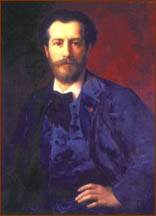|
DAILY NEWS ONLINE |
|
|
|
OTHER EDITIONS |
|
|
|
|
|
|
|
|
|
OTHER LINKS |
|
|
|
|
|
|
 |
Auguste Bartholdi, the creator of the symbolic concept of democracyWHATEVER it may have been, one must seek it between the years of 1872-1882 which were the formative golden decade of France, especially in the world of art, sculpture and architecture.
There was a doctrine and a technique the masters believed and they practised it consistently. But critics found it vaguer and less significant than a doctrine. It was their attitude to life and art but they were inspired by the motivation of artists and sculptors who shared a new vision that was essentially 'modern' and passionate. This led them to the discovery of Paganism, but things were happening. The followers of Courbet and Manet who were earlier influenced by Corot held an exhibition in 1874 when forty years before, a genius was born who with their influence, was to create history not in his France but in the United States of America. He was to be the creator of The Statue of Liberty. France has made its impact on the symbolism of democracy in the United States of America by its most famous monument, the statue of Liberty sculpted by Frenchman, Auguste Bartholdi whose centenary of death provides an insight to look over at the rich creativity of a master whose skill at works showcase the major French cities along with New York and Washington. The prestigious Colmar and Belfort museums too pay tribute by their special presentations of exhibitions of Bartholdi's work throughout the first few months of 2005. Two academics, Robert Belot and Daniel Bermond have just published Bartholdi's biography in France. These two internationally famous writers have combined their initiatives to surface the exceptional creativity of France's famous son and Alsation sculptor who crafted the symbolic figure of the concept of democracy and keeps reminding the world of the freedom of mankind through democracy as well as justice for all. It is one of the most remarkable contributions to mankind by an artist whose thinking power prevailed for the future generations. There was something like a common inspiration to devise means of expression of freedom, to perfectly understand the liberty of mind and body so that brotherhood among nations can be tied up by the bondage of beauty in democracy. It would have taken this Frenchman heights to scale and barriers to overcome to signify by vision the peace the world should enjoy, what nations could share between themselves. So Bartholdi put into the grit of stone the everlasting symbol of democracy, the mother of liberty and dignity of mankind into an angelic stone statue that spans not only America, the world, the seas but oceans of minds attracted to freedom. The light and shadow it casts as the revolving sun crosses space, beneath the soil lies his spirit, resting in peace. The Statue of Liberty may be the world's most famous sculpture, but the life of its sculptor remains unknown. And yet, Auguste Bartholdi, the centenary of whose death is being honoured this year, is probably one of the greatest sculptors of the 19th century, a man who infused his monumental sculptures with inimitable emotion. A biography co-written by Robert Belot and Daniel Bermond has just been published in France to right this injustice and pay homage to the man who devoted all his energy to celebrating liberty and venerating the heroes of the Third Republic. The Belfort and Colmar museums have also joined forces to present an exceptional exhibition on Bartholdi and his famous Lion of Belfort, a replica of which sits in state in the middle of the Place Denfert-Rochereau in Paris. Auguste Bartholdi was born in Colmar, Alsace in eastern France in 1834. He set up his first studio in Paris when he was just sixteen years. In 1855-1856, the artist made an inspiring trip to Egypt and Yeman and returned with armfuls of photographs and drawings, enthralled by the Egyptian sculptors' sense of magic and mystery. Bartholdi's talent won formal acclaim with the unveiling of the Lion of Belfort in 1880. The lion rising up on its haunches as if disturbed in its sleep was to become a symbol of pride for an entire region, which refused to accept Germany's annexation of Alsace-Lorraine. Sadly, the sculptor died in Paris in 1904 without ever again seeing his native Alsace, occupied by Germany. Bartholdi's work can be seen in many French towns and cities worldwide. Just some examples are the sculptures in the Longchamp Palace in Marseilles, the Place des Terreaux fountain in Lyons, the Gribeauval statue in Les Invalides and the La Fayette and Washington monument at the Place des Etats-Unis in Paris. Washington owes him the Capitol fountain, New York his statue of Lafayette arriving in America in Union Square, and Basel his Switzerland Succoring Strasbourg statue. Bartholdi also immortalised the great men who made France: his bronze statues honour Rouget de Lisle, composer of La Marseillaise, republican Leon Gambetta, Egyptologist Champollion and Enlightenment philosopher Diderot. Auguste Bartholdi was accepted by all regimes, as much by Napoleon III's Second Empire as by the Third Republic. Yet as Robert Belot and Daniel Bermond point out, he gradually became a staunch believer in republican ideals. This can be seen from Bartholdi's greatest work, the Statue of Liberty, which embodies his faith in universalism and democracy. |
|
|
 While seven of France's great Masters were identified as the
Impressionists, there were others who were doing better outside France
both as painters and sculptors.
While seven of France's great Masters were identified as the
Impressionists, there were others who were doing better outside France
both as painters and sculptors. 



